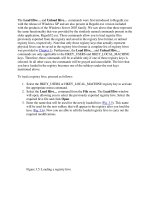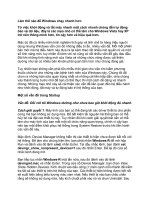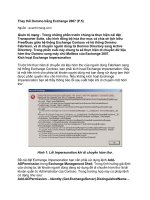Tài liệu DocBox the Definitive Guide-Chapter 4. Publishing DocBook Documents ppt
Bạn đang xem bản rút gọn của tài liệu. Xem và tải ngay bản đầy đủ của tài liệu tại đây (99.69 KB, 48 trang )
Chapter 4. Publishing DocBook Documents
Creating and editing SGML/XML documents is usually only half the battle.
After you've composed your document, you'll want to publish it. Publishing,
for our purposes, means either print or web publishing. For SGML and XML
documents, this is usually accomplished with some kind of stylesheet. In the
(not too distant) future, you may be able to publish an XML document on
the Web by simply putting it online with a stylesheet, but for now you'll
probably have to translate your document into HTML.
There are many ways, using both free and commercial tools, to publish
SGML documents. In this chapter, we're going to survey a number of
possibilities, and then look at just one solution in detail: Jade
and the
Modular DocBook Stylesheets.
We used jade to produce this book and to
produce the online versions on the CD-ROM; it is also being deployed in
other projects such as <SGML>&tools;,
which originated with the Linux
Documentation Project.
For a brief survey of other tools, see Appendix D
.
4.1. A Survey of Stylesheet Languages
Over the years, a number of attempts have been made to produce a standard
stylesheet language and, failing that, a large number of proprietary
languages have been developed.
FOSIs
First, the U.S. Department of Defense, in an attempt to standardize
stylesheets across military branches, created the Output Specification,
which is defined in MIL-PRF-28001C, Markup Requirements and
Generic Style Specification for Electronic Printed Output and
Exchange of Text.[1]
Commonly called FOSIs (for Formatting Output Specification
Instances), they are supported by a few products including ADEPT
Publisher by Arbortext
and DL Composer by Datalogics.
DSSSL
Next, the International Organization for Standardization (ISO) created
DSSSL, the Document Style Semantics and Specification Language.
Subsets of DSSSL are supported by Jade and a few other tools, but it
never achieved widespread support.
CSS
The W3C CSS Working Group created CSS as a style attachment
language for HTML, and, more recently, XML.
XSL
Most recently, the XML effort has identified a standard Extensible
Style Language (XSL) as a requirement. The W3C XSL Working
Group is currently pursuing that effort.
4.1.1. Stylesheet Examples
By way of comparison, here's an example of each of the standard style
languages. In each case, the stylesheet fragment shown contains the rules
that reasonably formatted the following paragraph:
<para>
This is an example paragraph. It should be
presented in a
reasonable body font.
<emphasis>Emphasized</emphasis> words
should be printed in italics. A single level of
<emphasis>Nested <emphasis>emphasis</emphasis>
should also
be supported.</emphasis>
</para>
4.1.1.1. FOSI stylesheet
FOSIs are SGML documents. The element in the FOSI that controls the
presentation of specific elements is the e-i-c (element in context) element.
A sample FOSI fragment is shown in Example 4-1
.
Example 4-1. A Fragment of a FOSI Stylesheet
<e-i-c gi="para">
<charlist>
<textbrk startln="1" endln="1">
</charlist>
</e-i-c>
<e-i-c gi="emphasis">
<charlist inherit="1">
<font posture="italic">
</charlist>
</e-i-c>
<e-i-c gi="emphasis" context="emphasis">
<charlist inherit="1">
<font posture="upright">
</charlist>
</e-i-c>
4.1.1.2. DSSSL stylesheet
DSSSL stylesheets are written in a Scheme-like language (see "Scheme"
later in this chapter). It is the element function that controls the
presentation of individual elements. See the example in Example 4-2
.
Example 4-2. A Fragment of a DSSSL Stylesheet
(element para
(make paragraph
(process-children)))
(element emphasis
(make sequence
font-posture: 'italic
(process-children)))
(element (emphasis emphasis)
(make sequence
font-posture: 'upright
(process-children)))
4.1.1.3. CSS stylesheet
CSS stylesheets consist of selectors and formatting properties, as shown in
Example 4-3
.
Example 4-3. A Fragment of a CSS Stylesheet
para { display: block }
emphasis { display: inline;
font-style: italic; }
emphasis emphasis { display: inline;
font-style: upright; }
4.1.1.4. XSL stylesheet
XSL stylesheets are XML documents, as shown in Example 4-4
. The
element in the XSL stylesheet that controls the presentation of specific
elements is the xsl:template element.
Example 4-4. A Fragment of an XSL Stylesheet
<?xml version='1.0'?>
<xsl:stylesheet
xmlns:xsl="
xmlns:fo="
<xsl:template match="para">
<fo:block>
<xsl:apply-templates/>
</fo:block>
</xsl:template>
<xsl:template match="emphasis">
<fo:sequence font-style="italic">
<xsl:apply-templates/>
</fo:sequence>
</xsl:template>
<xsl:template match="emphasis/emphasis">
<fo:sequence font-style="upright">
<xsl:apply-templates/>
</fo:sequence>
</xsl:template>
</xsl:stylesheet>
4.2. Using Jade and DSSSL to Publish DocBook Documents
Jade is a free tool that applies DSSSL
stylesheets to SGML and XML
documents. As distributed, Jade can output RTF, TeX, MIF, and SGML.
The SGML backend can be used for SGML to SGML transformations (for
example, DocBook to HTML).
A complete set of DSSSL stylesheets for creating print and HTML output
from DocBook is included on the CD-ROM. More information about
obtaining and installing Jade appears in Appendix A
. >
4.3. A Brief Introduction to DSSSL
DSSSL is a stylesheet language for both print and online rendering. The
acronym stands for Document Style Semantics and Specification Language.
It is defined by ISO/IEC 10179:1996. For more general information about
DSSSL, see the DSSSL Page
.
4.3.1. Scheme
The DSSSL expression language is Scheme, a variant of Lisp. Lisp is a
functional programming language with a remarkably regular syntax. Every
expression looks like this:
(operator [arg1] [arg2] [argn] )
This is called "prefix" syntax because the operator comes before its
arguments.
In Scheme, the expression that subtracts 2 from 3, is (- 3 2). And (+ (-
3 2) (* 2 4)) is 9. While the prefix syntax and the parentheses may
take a bit of getting used to, Scheme is not hard to learn, in part because
there are no exceptions to the syntax.
4.3.2. DSSSL Stylesheets
A complete DSSSL stylesheet is shown in Example 4-5
. After only a brief
examination of the stylesheet, you'll probably begin to have a feel for how it
works. For each element in the document, there is an element rule that
describes how you should format that element. The goal of the rest of this
chapter is to make it possible for you to read, understand, and even write
stylesheets at this level of complexity.
Example 4-5. A Complete DSSSL Stylesheet
<!DOCTYPE style-sheet PUBLIC "-//James Clark//DTD
DSSSL Style Sheet//EN">
<style-sheet>
<style-specification>
<style-specification-body>
(element chapter
(make simple-page-sequence
top-margin: 1in
bottom-margin: 1in
left-margin: 1in
right-margin: 1in
font-size: 12pt
line-spacing: 14pt
min-leading: 0pt
(process-children)))
(element title
(make paragraph
font-weight: 'bold
font-size: 18pt
(process-children)))
(element para
(make paragraph
space-before: 8pt
(process-children)))
(element emphasis
(if (equal? (attribute-string "role") "strong")
(make sequence
font-weight: 'bold
(process-children))
(make sequence
font-posture: 'italic
(process-children))))
(element (emphasis emphasis)
(make sequence
font-posture: 'upright
(process-children)))
(define (super-sub-script plus-or-minus
#!optional (sosofo (process-
children)))
(make sequence
font-size: (* (inherited-font-size) 0.8)
position-point-shift: (plus-or-minus (*
(inherited-font-size) 0.4))
sosofo))
(element superscript (super-sub-script +))
(element subscript (super-sub-script -))
</style-specification-body>
</style-specification>
</style-sheet>
This stylesheet is capable of formatting simple DocBook documents like the
one shown in Example 4-6
.
Example 4-6. A Simple DocBook Document
<!DOCTYPE chapter PUBLIC "-//OASIS//DTD DocBook
V3.1//EN">
<chapter><title>Test Chapter</title>
<para>
This is a paragraph in the test chapter. It is
unremarkable in
every regard. This is a paragraph in the test
chapter. It is
unremarkable in every regard. This is a paragraph
in the test
chapter. It is unremarkable in every regard.
</para>
<para>
<emphasis role=strong>This</emphasis> paragraph
contains
<emphasis>some <emphasis>emphasized</emphasis>
text</emphasis>
and a <superscript>super</superscript>script
and a <subscript>sub</subscript>script.
</para>
<para>
This is a paragraph in the test chapter. It is
unremarkable in
every regard. This is a paragraph in the test
chapter. It is
unremarkable in every regard. This is a paragraph
in the test
chapter. It is unremarkable in every regard.
</para>
</chapter>
The result of formatting a simple document with this stylesheet can be seen
in Figure 4-1
.
Figure 4-1. The formatted simple document
We'll take a closer look at this stylesheet after you've learned a little more
DSSSL.
4.3.3. DSSSL Stylesheets Are SGML Documents
One of the first things that may strike you about DSSSL stylesheets (aside
from all the parentheses), is the fact that the stylesheet itself is an SGML
document! This means that you have all the power of SGML documents at
your disposal in DSSSL stylesheets. In particular, you can use entities and
marked sections to build a modular stylesheet.
In fact, DSSSL stylesheets are defined so that they correspond to a particular
architecture. This means that you can change the DTD used by stylesheets
within the bounds of the architecture. A complete discussion of document
architectures is beyond the scope of this book, but we'll show you one way
to take advantage of them in your DSSSL stylesheets in Section 4.6
" later in
the chapter.
4.3.4. DSSSL Processing Model
A DSSSL processor builds a tree out of the source document. Each element
in the source document becomes a node in the tree (processing instructions
and other constructs become nodes as well). Processing the source tree
begins with the root rule and continues until there are no more nodes to
process.
4.3.5. Global Variables and Side Effects
There aren't any global variables or side effects. It can be difficult to come to
grips with this, especially if you're just starting out.
It is possible to define constants and functions
and to create local variables
with let expressions
, but you can't create any global variables or change
anything after you've defined it.
4.3.6. DSSSL Expressions
DSSSL has a rich vocabulary of expressions for dealing with all of the
intricacies of formatting. Many, but by no means all of them, are supported
by Jade. In this introduction, we'll cover only a few of the most common.
4.3.6.1. Element expressions
Element expressions, which define the rules for formatting particular
elements, make up the bulk of most DSSSL stylesheets. A simple element
rule can be seen in Example 4-7
. This rule says that a para element should
be formatted by making a paragraph (see Section 4.3.6.2
").
Example 4-7. A Simple DSSSL Rule
(element para
(make paragraph
space-before: 8pt
(process-children)))
An element expression can be made more specific by specifying an element
and its ancestors instead of just specifying an element. The rule (element
title ) applies to all Title
elements, but a rule that begins
(element (figure title) ) applies only to Title
elements
that are immediate children of Figure
elements.
If several rules apply, the most specific rule is used.
When a rule is used, the node in the source tree that was matched becomes
the "current node" while that element expression is being processed.
4.3.6.2. Make expressions
A make expression specifies the characteristics of a "flow object." Flow
objects are abstract representations of content (paragraphs, rules, tables, and
so on). The expression:
(make paragraph
font-size: 12pt
line-spacing: 14pt )
specifies that the content that goes "here" is to be placed into a paragraph
flow object with a font-size of 12pt and a line-spacing of 14pt (all of the
unspecified characteristics of the flow object are defaulted in the appropriate
way).
They're called flow objects because DSSSL, in its full generality, allows you
to specify the characteristics of a sequence of flow objects and a set of areas
on the physical page where you can place content. The content of the flow
objects is then "poured on to" (or flows in to) the areas on the page(s).
In most cases, it's sufficient to think of the make expressions as constructing
the flow objects, but they really only specify the characteristics of the flow
objects. This detail is apparent in one of the most common and initially
confusing pieces of DSSSL jargon: the sosofo. Sosofo stands for a
"specification of a sequence of flow objects." All this means is that
processing a document may result in a nested set of make expressions (in
other words, the paragraph may contain a table that contains rows that
contain cells that contain paragraphs, and so on).
The general form of a make expression is:
(make flow-object-name
keyword1: value1
keyword2: value2
keywordn: valuen
(content-expression))
Keyword arguments specify the characteristics of the flow object. The
specific characteristics you use depends on the flow object. The content-
expression can vary; it is usually another make expression or one of the
processing expressions
.
Some common flow objects in the print stylesheet are:
simple-page-sequence
Contains a sequence of pages. The keyword arguments of this flow
object let you specify margins, headers and footers, and other page-
related characteristics. Print stylesheets should always produce one or
more simple-page-sequence flow objects.
Nesting simple-page-sequence does not work. Characteristics
on the inner sequences are ignored.
paragraph
A paragraph is used for any block of text. This may include not only
paragraphs in the source document, but also titles, the terms in a
definition list, glossary entries, and so on. Paragraphs in DSSSL can
be nested.
sequence
A sequence is a wrapper. It is most frequently used to change
inherited characteristics (like font style) of a set of flow objects
without introducing other semantics (such as line breaks).
score
A score flow object creates underlining, strike-throughs, or overlining.
table
A table flow object creates a table of rows and cells.
The HTML stylesheet uses the SGML backend, which has a different
selection of flow objects.
element
Creates an element. The content of this make expression will appear
between the start and end tags. The expression:
(make element gi: "H1"
(literal "Title"))
produces <H1>Title</H1>.
empty-element
Creates an empty element that may not have content. The expression:
(make empty-element gi: "BR"
attributes: '(("CLEAR" "ALL")))
produces <BR CLEAR="ALL">.
sequence
Produces no output in of itself as a wrapper, but is still required in
DSSSL contexts in which you want to output several flow objects but
only one object top-level object may be returned.
entity-ref
Inserts an entity reference. The expression:
(make entity-ref name: "nbsp")
produces .
In both stylesheets, a completely empty flow object is constructed with
(empty-sosofo).
4.3.6.3. Selecting data
Extracting parts of the source document can be accomplished with these
functions:
(data nd)
Returns all of the character data from nd as a string.
(attribute-string "attr" nd)
Returns the value of the attr attribute of nd.
(inherited-attribute-string "attr" nd)
Returns the value of the attr attribute of nd. If that attribute is not
specified on nd, it searches up the hierarchy for the first ancestor
element that does set the attribute, and returns its value.
4.3.6.4. Selecting elements
A common requirement of formatting is the ability to reorder content. In
order to do this, you must be able to select other elements in the tree for
processing. DSSSL provides a number of functions that select other
elements. These functions all return a list of nodes.
(current-node)
Returns the current node.
(children nd)
Returns the children of nd.
(descendants nd)
Returns the descendants of nd (the children of nd and all their
children's children, and so on).
(parent nd)
Returns the parent of nd.
(ancestor "name" nd)
Returns the first ancestor of nd named name.
(element-with-id "id")
Returns the element in the document with the ID id, if such an
element exists.
(select-elements node-list "name")
Returns all of the elements of the node-list that have the name
name. For example, (select-elements (descendants
(current-node)) "para") returns a list of all the paragraphs
that are descendants of the current node.
(empty-node-list)
Returns a node list that contains no nodes.
Other functions allow you to manipulate node lists.
(node-list-empty? nl)
Returns true if (and only if) nl is an empty node list.
(node-list-length nl)
Returns the number of nodes in nl.
(node-list-first nl)
Returns a node list that consists of the single node that is the first node
in nl.
(node-list-rest nl)
Returns a node list that contains all of the nodes in nl except the first
node.
There are many other expressions for manipulating nodes and node lists.
4.3.6.5. Processing expressions
Processing expressions control which elements in the document will be
processed and in what order. Processing an element is performed by finding
a matching element rule and using that rule.
(process-children)
Processes all of the children of the current node. In most cases, if no
process expression is given, processing the children is the default
behavior.
(process-node-list nl)
Processes each of the elements in nl.
4.3.6.6. Define expressions
You can declare your own functions and constants in DSSSL. The general
form of a function declaration is:
(define (function args)
function-body)
A constant declaration is:
(define constant
constant-function-body)
The distinction between constants and functions is that the body of a
constant is evaluated when the definition occurs, while functions are
evaluated when they are used.
4.3.6.7. Conditionals
In DSSSL, the constant #t represents true and #f false. There are several
ways to test conditions and take action in DSSSL.
if
The form of an if expression is:
(if condition
true-expression
false-expression)
If the condition is true, the true-expression is evaluated,
otherwise the false-expression is evaluated. You must always
provide an expression to be evaulated when the condition is not met.
If you want to produce nothing, use (empty-sosofo).
case
case selects from among several alternatives:
(case expression
((constant1) (expression1))
((constant2) (expression2))
((constant3) (expression3))
(else else-expression))
The value of the expression is compared against each of the constants
in turn and the expression associated with the first matching constant
is evaulated.
cond
cond also selects from among several alternatives, but the selection is
performed by evaluating each expression:
(cond
((condition1) (expression1))
((condition2) (expression2))
((condition3) (expression3))
(else else-expression))
The value of each conditional is calculated in turn. The expression
associated with the first condition that is true is evaluated.
Any expression that returns #f is false; all other expressions are true. This
can be somewhat counterintuitive. In many programming languages, it's
common to assume that "empty" things are false (0 is false, a null pointer is
false, an empty set is false, for example.) In DSSSL, this isn't the case; note,
for example, that an empty node list is not #f and is therefore true. To avoid
these difficulties, always use functions that return true or false in
conditionals. To test for an empty node list, use (node-list-empty?).
4.3.6.8. Let expressions
The way to create local variables in DSSSL is with (let). The general
form of a let expression is:
(let ((var1 expression1)
(var2 expression2)
(varn expressionn))
let-body)
In a let; expression, all of the variables are defined "simultaneously." The
expression that defines var2 cannot contain any references to any other
variables defined in the same let expression. A let* expression allows
variables to refer to each other, but runs slightly slower.
Variables are available only within the let-body. A common use of let
is within a define expression:
(define (cals-rule-default nd)
(let* ((table (ancestor "table" nd))
(frame (if (attribute-string "frame"
table)
(attribute-string "frame"
table)
"all")))
(equal? frame "all")))
This function creates two local variables table and frame. let returns
the value of the last expression in the body, so this function returns true if
the frame attribute on the table is all or if no frame attribute is present.
4.3.6.9. Loops
DSSSL doesn't have any construct that resembles the "for loop" that occurs
in most imperative languages like C and Java. Instead, DSSSL employs a
common trick in functional languages for implementing a loop: tail
recursion.
Loops in DSSSL use a special form of let. This loop counts from 1 to 10:
(let (1)loopvar (2)((count 1))
(3)(if (> count 10)
(4)#t
((5)loopvar (6)(+ count 1))))
(1)
This variable controls the loop. It is declared without an initial value,
immediately after the let operand.
(2)
Any number of additional local variables can be defined after the loop
variable, just as they can in any other let expression.
(3)
If you ever want the loop to end, you have to put some sort of a test in
it.
(4)
This is the value that will be returned.
(5)
Note that you iterate the loop by using the loop variable as if it was a
function name.
(6)
The arguments to this "function" are the values that you want the local
variables declared in (2)
to have in the next iteration.
4.3.7. A Closer Look at Example 4-5
Example 4-5
is a style sheet that contains a style specification. Stylesheets
may consist of multiple specifications, as we'll see in Section 4.4.3
."
The actual DSSSL code goes in the style specification body, within the style
specification. Each construction rule processes different elements from the
source document.
4.3.7.1. Processing chapters
Chapter
s are processed by the chapter construction rule. Each
Chapter
is formatted as a simple-page-sequence. Every print
stylesheet should format a document as one or more simple page sequences.
Characteristics on the simple page sequence can specify headers and footers
as well as margins and other page parameters.
One important note about simple page sequences: they cannot nest. This
means that you cannot blindly process divisions (Part
s, Reference) and
the elements they contain (Chapter
s, RefEntrys) as simple page
sequences. This sometimes involves a little creativity.
4.3.7.2. Processing titles









